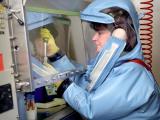Dec 3, 2003 (CIDRAP News) Systems for rapidly detecting contaminants in drinking water should be a high priority for federal funding to make the nation's water systems more secure, according to a group of experts consulted by Congress's General Accounting Office (GAO).
Almost 70% of specialists (30 of 43) polled by the GAO said systems to provide "near real-time data" on water contaminants should rank first among potential technological security enhancements for water systems, according to a GAO report released yesterday.
The experts also called for improved education and training for water-system security workers and for strengthening ties between water utilities and other organizations such as public health and law enforcement agencies.
The GAO surveyed water-system security experts for their views on the major vulnerabilities of the nation's drinking water systems, criteria for allocating federal funds for water system security, and specific security improvements needed. The agency used the Delphi survey method, a systematic process for obtaining individuals' views and seeking consensus.
The report notes that Congress has appropriated more than $100 million since Sep 11, 2001, to help water utilities assess their vulnerability to terrorist attacks and develop response plans. Bioterrorism legislation passed in 2002 required water systems serving more than 3,300 people to assess their vulnerabilities by specified dates in 2003 or 2004, depending on system size.
The experts said monitoring systems are "critical in efforts to quickly detect contamination events, minimize their impact, and restore systems after an event has passed." Concerning other technological improvements, the panelists voiced strong support for increasing laboratories' capacity to deal with increased workloads caused by contamination of water supplies. They also supported improving the physical security of water systems by adding or repairing fences, locks, lighting systems, and surveillance equipment.
More than half of the panelists (24 of 43) ranked improved technical training for security personnel as a high priority for funding. In the same vein, 38 of 43 experts said regional simulation exercises to test emergency response plans should be a high priority.
The panel also cited a need to improve cooperation and coordination between water systems and other agencies such as public health and law enforcement. Further, the experts called for cooperation between neighboring utilities on such needs as back-up power systems.
About 75% of the experts said distribution systems are among the most vulnerable components of water systems, according to the report. One expert said that since the water in a distribution system has already been treated and is on its way to consumers, contaminants could be difficult to detect until they have already done harm.
Other water system components cited as vulnerable to tampering were reservoirs and other water sources; computer systems used to manage system functions; and supplies of treatment chemicals, such as chlorine gas.
See also:
The GAO report "Drinking water: Experts' views on how future federal funding can best be spent to improve security" [Full text]

















